POLAND’S INDEPENDENCE GUARANTEED
London, England · March 31, 1939
On this date in 1939, two weeks after German troops entered Prague and all of Czechoslovakia fell under the German boot, the British government, followed a few days later by the French, pledged to guarantee the independence (though interestingly not the territorial integrity) of Poland. A week later the three states announced a formal alliance when Polish Foreign Minister Józef Beck visited London.
That the Western democracies would guarantee Poland’s independence so enraged Adolf Hitler that he told commanders of his Wehrmacht (German armed forces) to begin strategic planning for Fall Weiss (Operation White), the destruction of Poland, with a provisional start date of September 1, 1939. A defeated Poland would eliminate the “Free City of Danzig” (German, Freie Stadt Danzig), consisting of the Baltic seaport of Danzig (today’s Gdańsk) and surrounding areas, which were roughly 95 percent ethnic German. This geographical oddity of the 1919 Versailles Peace Treaty was administered by a League of Nations high commissioner (at the time, a Swiss), and most Germans found Danzig’s existence a vexation because it and the so-called Polish Corridor split East Prussia from West Prussia and the rest of Nazi Germany (see map). German units were to invade Poland from three directions: the main attack from Germany across the western Polish border, a second route from the East Prussian enclave, and a third attack by German and allied Slovak units from the Czech puppet state (since March 14, 1939) of Slovakia. All three assaults were to converge on Warsaw, the Polish capital.
Fall Weiss was the first European military operation of World War II. It would be six years of brutal occupation and the death of four million Polish civilians, three-quarters of them Jews who died in concentration camps or gas chambers, before the last units of the Wehrmacht were swept from Polish soil. As for Danzig itself, many of its residents perished or fled westward ahead of the Soviet onslaught and the city’s destruction and conquest by the Red Army in March 1945. After the war most of the remaining ethnic Germans were forcibly expelled. The city was subsequently placed under Polish administration by the Allied Potsdam Agreement (August 1, 1945), and Poles from Central and Soviet-annexed Eastern Poland were brought in to replace the German population.
German Conquest of Poland, September 1 to October 6, 1939
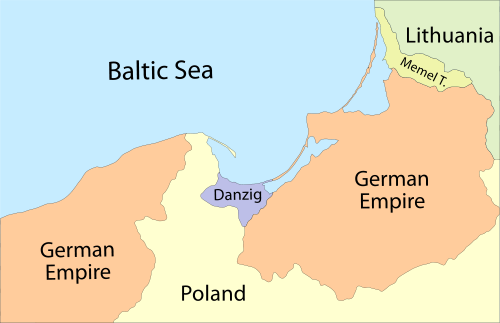 |
Above: Map of Danzig (“Free City of Danzig,” present-day Gdańsk) and Poland’s corridor to the Baltic Sea (“Polish Corridor”) squeezed between German West and East Prussia on the eve of war, 1939. The Memel Territory (today’s Kaliningrad Oblast) was retransferred by an intimidated Lithuania to Nazi Germany on March 23, 1939. This event proved to be the last of a series of bloodless annexations of territories separated from Germany by the 1919 Treaty of Versailles.
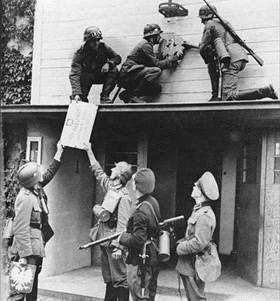 | 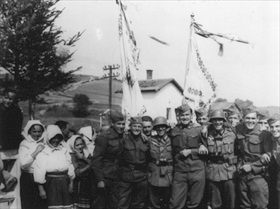 |
Left: German troops remove Polish insignia at the Polish-Danzig border near Sopot (German, Zoppot), September 1, 1939.
![]()
Right: German and Slovak soldiers pose with civilians in Komańcza, Southeastern Poland, September 1939.
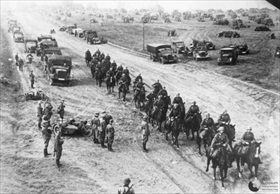 | 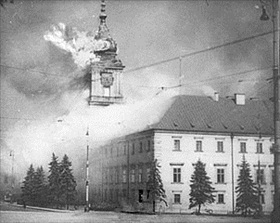 |
Left: German cavalry and motorized units enter Poland from East Prussia, 1939.
![]()
Right: The Polish Royal Castle in Warsaw on fire after being shelled by Germans, September 17, 1939. On September 26 German troops captured three key forts defending Warsaw and entered the capital the next day.
Silent German Propaganda Film “Liberation” of Danzig and Wehrmacht’s Assault on Poland, September 1939
![]()

 History buffs, there is good news! The Daily Chronicles of World War II is now available as an ebook for $4.99 on Amazon.com. Containing a year’s worth of dated entries from this website, the ebook brings the story of this tumultuous era to life in a compelling, authoritative, and succinct manner. Featuring inventive navigation aids, the ebook enables readers to instantly move forward or backward by month and date to different dated entries. Simple and elegant! Click
History buffs, there is good news! The Daily Chronicles of World War II is now available as an ebook for $4.99 on Amazon.com. Containing a year’s worth of dated entries from this website, the ebook brings the story of this tumultuous era to life in a compelling, authoritative, and succinct manner. Featuring inventive navigation aids, the ebook enables readers to instantly move forward or backward by month and date to different dated entries. Simple and elegant! Click 











